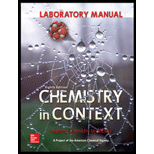
Concept explainers
(a)
Interpretation:
The combustion of coal release several substances into the air. Of these substances, one is a gas that is produced in large amounts; its chemical formula and name have to be given.
Concept Introduction:
A fuel is a substance which releases energy in the form of heat while undergoing combustion. Hydrocarbons which have high heats of combustion make it a best fuel.
The general equation for the complete combustion of a hydrocarbon is written below,
Coal is a good fuel becouse it is completely made up of carbon atoms. It is a fossil fuel.
Coals can be classified and graded according to the carbon percent and the impurity percent such as sulfur.
Anthracite coal has high carbon content.
(b)
Interpretation:
The combustion of coal release several substances into the air. In contrast, the amount of sulfur dioxide released is relatively small. Even so, this
Concept Introduction:
A fuel is a substance which releases energy in the form of heat while undergoing combustion. Hydrocarbons which have high heats of combustion make it a best fuel.
The general equation for the complete combustion of a hydrocarbon is written below,
Coal is a good fuel becouse it is completely made up of carbon atoms. It is a fossil fuel.
Coals can be classified and graded according to the carbon percent and the impurity percent such as sulfur.
Anthracite coal has high carbon content.
(c)
Interpretation:
The combustion of coal release several substances into the air.
Concept Introduction:
Heat of combustion: It is also known as potential heat of fuel. Heat of combustion of carbon depends on its allotropic form.
A fuel is a substance which releases energy in the form of heat while undergoing combustion. Hydrocarbons which have high heats of combustion make it a best fuel.
Coal is a good fuel becouse it is completely made up of carbon atoms. It is a fossil fuel.
Coals can be classified and graded according to the carbon percent and the impurity percent such as sulfur.
(d)
Interpretation:
The combustion of coal release several substances into the air. When coal burns, fine particles of soot may be released. The health concerns with
Concept Introduction:
Heat of combustion: It is also known as potential heat of fuel. Heat of combustion of carbon depends on its allotropic form.
A fuel is a substance which releases energy in the form of heat while undergoing combustion. Hydrocarbons which have high heats of combustion make it a best fuel.
Coal is a good fuel becouse it is completely made up of carbon atoms. It is a fossil fuel.
Coals can be classified and graded according to the carbon percent and the impurity percent such as sulfur.
Particulate matter (PM) is a complex mixture of air borne particles that differ in size, origin and chemical composition, all of which are
Want to see the full answer?
Check out a sample textbook solution
Chapter 4 Solutions
Laboratory Manual Chemistry in Context
- Propose a synthesis of 1-butanamine from the following: (a) a chloroalkane of three carbons (b) a chloroalkane of four carbonsarrow_forwardSelect the stronger base from each pair of compounds. (a) H₂CNH₂ or EtzN (b) CI or NH2 NH2 (c) .Q or EtzN (d) or (e) N or (f) H or Harrow_forward4. Provide a clear arrow-pushing mechanism for each of the following reactions. Do not skip proton transfers, do not combine steps, and make sure your arrows are clear enough to be interpreted without ambiguity. a. 2. 1. LDA 3. H3O+ HOarrow_forward
- b. H3C CH3 H3O+ ✓ H OHarrow_forward2. Provide reagents/conditions to accomplish the following syntheses. More than one step is required in some cases. a. CH3arrow_forwardIdentify and provide an explanation that distinguishes a qualitative and quantitative chemical analysis. Provide examples.arrow_forward
- Identify and provide an explanation of the operational principles behind a Atomic Absorption Spectrometer (AAS). List the steps involved.arrow_forwardInstructions: Complete the questions in the space provided. Show all your work 1. You are trying to determine the rate law expression for a reaction that you are completing at 25°C. You measure the initial reaction rate and the starting concentrations of the reactions for 4 trials. BrO³¯ (aq) + 5Br¯ (aq) + 6H* (aq) → 3Br₂ (l) + 3H2O (l) Initial rate Trial [BrO3] [H*] [Br] (mol/L) (mol/L) | (mol/L) (mol/L.s) 1 0.10 0.10 0.10 8.0 2 0.20 0.10 0.10 16 3 0.10 0.20 0.10 16 4 0.10 0.10 0.20 32 a. Based on the above data what is the rate law expression? b. Solve for the value of k (make sure to include proper units) 2. The proposed reaction mechanism is as follows: i. ii. BrО¸¯ (aq) + H+ (aq) → HBrO3 (aq) HBrO³ (aq) + H* (aq) → H₂BrO3* (aq) iii. H₂BrO³* (aq) + Br¯ (aq) → Br₂O₂ (aq) + H2O (l) [Fast] [Medium] [Slow] iv. Br₂O₂ (aq) + 4H*(aq) + 4Br(aq) → 3Br₂ (l) + H2O (l) [Fast] Evaluate the validity of this proposed reaction. Justify your answer.arrow_forwardе. Д CH3 D*, D20arrow_forward
 World of Chemistry, 3rd editionChemistryISBN:9781133109655Author:Steven S. Zumdahl, Susan L. Zumdahl, Donald J. DeCostePublisher:Brooks / Cole / Cengage Learning
World of Chemistry, 3rd editionChemistryISBN:9781133109655Author:Steven S. Zumdahl, Susan L. Zumdahl, Donald J. DeCostePublisher:Brooks / Cole / Cengage Learning
 Chemistry & Chemical ReactivityChemistryISBN:9781337399074Author:John C. Kotz, Paul M. Treichel, John Townsend, David TreichelPublisher:Cengage Learning
Chemistry & Chemical ReactivityChemistryISBN:9781337399074Author:John C. Kotz, Paul M. Treichel, John Townsend, David TreichelPublisher:Cengage Learning Chemistry & Chemical ReactivityChemistryISBN:9781133949640Author:John C. Kotz, Paul M. Treichel, John Townsend, David TreichelPublisher:Cengage Learning
Chemistry & Chemical ReactivityChemistryISBN:9781133949640Author:John C. Kotz, Paul M. Treichel, John Townsend, David TreichelPublisher:Cengage Learning Chemistry for Engineering StudentsChemistryISBN:9781337398909Author:Lawrence S. Brown, Tom HolmePublisher:Cengage Learning
Chemistry for Engineering StudentsChemistryISBN:9781337398909Author:Lawrence S. Brown, Tom HolmePublisher:Cengage Learning Chemistry In FocusChemistryISBN:9781305084476Author:Tro, Nivaldo J., Neu, Don.Publisher:Cengage Learning
Chemistry In FocusChemistryISBN:9781305084476Author:Tro, Nivaldo J., Neu, Don.Publisher:Cengage Learning





